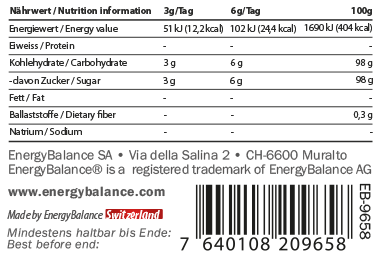- Temporarily out of stock.
Reference: EBC-ALA-180
Brand: EnergyBalance®
Alpha-Lipoic Acid 250mg (180 VegeCaps), EnergyBalance
ALA helps maintain normal blood cholesterol levels.
This highly pure D-mannose is an essential sugar. Mannose plays a major role in tissue and cell renewal. It is no longer in the diet and is mainly obtained from the aloe plant. It can also be found in special Chinese mushrooms. This product contains D-mannose in a highly pure form, is vegetable, gluten-free, lactose-free and suitable for diabetics.
This essential sugar can no longer be found in food today
The name mannose comes from manna, which the Bible describes as food that the Hebrews are said to have eaten during their journey through the Sinai Desert. Manna is a sweet extract and is found in several trees and shrubs, such as Fraxinus ornus, also known as manna ash.
Mannose is an epimer of glucose. As D-mannose, it is a natural hexose and a component of numerous plant polysaccharides (mannans). It is an important part of membranes in the body.
Mannose plays a major role in tissue and cell renewal. It is no longer in the diet and is mainly obtained from the aloe plant. It can also be found in special Chinese mushrooms.
The 8 essential sugars:
Galactose: improves cell communication and increases calcium absorption.
Glucose: especially helps to increase memory, stimulates calcium absorption and improves intercellular communication. Glucose is the sugar that is formed from carbohydrates in the metabolism.
Fructose: affects the development of the brain, especially long-term memory. It supplies the rapidly growing body of the newborn with glyconutrients.
Mannose: plays a major role in the renewal of tissue and cells. Mannose binds foreign substances in the urine bladder and prevents them from accumulating on the bladder wall. It is no longer in the diet. It can still be found in special Chinese mushrooms.
Xylose: Xylose supports intercellular communication and is not contained in food. It is often used as a sweetener in products for diabetics because it has only a minimal effect on the insulin balance in the body.
N-acetyl neuraminic acid: is very important for brain development, brain regeneration and pineal activity. The older a person gets, the less the organism can obtain N-acetylneuraminic acid from food. It is found in breast milk.
N-acetylglucosamine: is no longer present in the diet and can only be obtained from rare, untreated plants.
N-acetylgalactosamine: This recently discovered form of sugar helps with cell communication. It can no longer be found in food, but it can be obtained from plants at great expense.
---
Dosage: Dissolve 6 measuring spoons of 0.5g (= 3g) mannose in 1 glass of water and drink 1 to 2 times a day.
Contents: 200g powder D-mannose in a very pure form, water-soluble, slightly sweet in taste. The measuring spoon is included in the container.
Data sheet

Reference: EBC-ALA-180
Brand: EnergyBalance®
ALA helps maintain normal blood cholesterol levels.
Reference: EBC-2598
Brand: EnergyBalance®
This Potassium Crystal Deodorant Spray by EnergyBalance® is natural, fragrance-free, hypoallergenic, alcohol-free and aluminum chloride-free. Due to its special composition of natural minerals, it becomes a powerful antibacterial that allows the skin to breathe freely and guarantees remarkable results even in the most delicate zones. Natural...
Reference: EBC-BASBAD-400
Brand: EnergyBalance®
The first alkaline bath salts with coenzyme Q10, aloe vera, spirulina and reddish Mayo salt from the south of the Himalaya mountains. Perfect for balancing out your body's acid-alkaline levels. Even the ancient Egyptians and Romans cleaned their bodies with alkaline skin care products. We spend the first nine months before birth in alkaline amniotic...
Reference: EBC-ALA-90
Brand: EnergyBalance®
ALA helps maintain normal blood cholesterol levels.
Your review appreciation cannot be sent
Report comment
Report sent
Your report cannot be sent
Write your review
Review sent
Your review cannot be sent